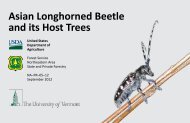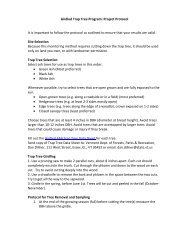Norway Maple, Acer platanoides Species Biology and Phenology ...
Norway Maple, Acer platanoides Species Biology and Phenology ...
Norway Maple, Acer platanoides Species Biology and Phenology ...
- No tags were found...
You also want an ePaper? Increase the reach of your titles
YUMPU automatically turns print PDFs into web optimized ePapers that Google loves.
<strong>Norway</strong> <strong>Maple</strong>, <strong>Acer</strong> <strong>platanoides</strong><strong>Species</strong> <strong>Biology</strong> <strong>and</strong> <strong>Phenology</strong>:Habitat: <strong>Norway</strong> maple is tolerant of a wide variety of soil, moisture, <strong>and</strong> light conditions. It prefers full sun, <strong>and</strong> can withst<strong>and</strong> hotdry conditions. It is tolerant of ozone <strong>and</strong> sulfur dioxide air pollution <strong>and</strong> has adapted to extremes in soils. This tree can be found inearly <strong>and</strong> late succession forests, forested wetl<strong>and</strong>s, open disturbed areas, roadsides, vacant lots, yards, <strong>and</strong> gardens. It has been foundin woodl<strong>and</strong>s near cities, especially in the northeast. <strong>Norway</strong> maple can be locally dominant in forest st<strong>and</strong>s, create dense shade, <strong>and</strong>displace native trees, shrubs, <strong>and</strong> herbs.Reproductive Strategy: The yellowish-green flowers of <strong>Norway</strong> maple appear in stalked clusters in mid to late April as the leaves areexp<strong>and</strong>ing. They are insect pollinated. Fruits mature in late summer into wide-spreading wings that split down the middle. Largenumbers of shade-tolerant seedlings are produced. Populations of these trees will also exp<strong>and</strong> locally by vegetative reproduction.Dispersal: Seeds are wind dispersed in fall, providing a high likelihood of protection under winter snow – conditions usually sufficientfor stratification as well as protection from extreme cold.<strong>Species</strong> <strong>Phenology</strong> <strong>and</strong> Treatment Options:<strong>Phenology</strong>FloweringFull leaf outSeed ripeningMonth JAN FEB MAR APR MAY JUN JUL AUG SEPT OCT NOV DECManual H<strong>and</strong> pulling <strong>and</strong> diggingChemicalCuttingBasal bark herbicideFoliar herbicideCut surface herbicide
Treatment Methods:Category Method Method Description ConsiderationsManual treatment can be moderately to highly effective for <strong>Norway</strong> mapleMANUALCHEMICALH<strong>and</strong>PullingWeedWrenchingCutting• Pull entire plant by the base of the stem• Be sure to remove entire root system.• Dry or burn all vegetation (most importantly roots) byhanging upside down on surrounding vegetation orpiling into a brush pile <strong>and</strong> burning.• Remove plant by the base of the stem• Be sure to remove entire root system• Dry or burn all vegetation (most importantly roots) byhanging upside down on surrounding vegetation orpiling into a brush pile <strong>and</strong> burning.• Use lopper, pruning shears, weed whacker/brush saw ormower to cut the stem as close to the ground as possible• Cut at least 1 times during growing season (mid May-October)• Repeat for 3-5 years• Active ingredients commonly used in herbicides: Glyphosate or triclopyrFoliar If foliar spraying only:Application • Foliar spray when plant is fully leafed out• Spray leaf surfaces with low volume backpack sprayerIf foliar wiping:• Foliar wipe when plant is fully leafed out• Wear a heavy, chemical resistant rubber glove with acloth glove over the rubber glove• Apply the herbicide to coat the surface of the leaves• Effective on small sized plants <strong>and</strong> small infestations• Most effective if done when soil is wet• Remaining portions of root system not removed canre-sprout• Effective on small to medium sized plants• Cutting/mowing can help slow the spread of <strong>Norway</strong><strong>Maple</strong>• Cutting/mowing will encourage re-sprouting <strong>and</strong>may need to be conducted for 3-5 years to fullyexhaust root system <strong>and</strong> kill plant• Most effective if followed with foliar herbicideapplicationLow Volume Backpack Sprayer• Herbicides (active ingredient): tricolpyr withsurfactant, glyphosate with surfactant.• Used to target dense infestations of small to mediumsized <strong>Norway</strong> <strong>Maple</strong>sFoliar Wipe• Herbicides (active ingredient): tricolpyr withsurfactant or glyphosate with surfactant• Used for infestations that have desirable, nativevegetation that will be damaged by drift of a foliarspray or for small infestations
Cut StumpBasal BarkCut Surface• Cut stems in late summer to early fall• Apply herbicide immediately after cutting the exposedsurface using a sponge, brush, h<strong>and</strong>-held squirt bottleor directly pouring• Apply herbicide to at least the outer 20% of the surface• Monitor <strong>and</strong> do follow up treatment as the followingyear <strong>and</strong> as necessary• Us a low pressure, low volume backpack sprayer• Apply herbicide around the entire circumference of thelower 8-18” of individual stems of the plant <strong>and</strong> includethe root collar• Larger stems require the larger (18”) treated area• Do not spray to the point of runoff• Cut stems 2-4” above the ground• Apply herbicide up to one month following cuttingusing a sprayer, h<strong>and</strong>-held squirt bottle or directlypouring• Apply herbicide around the entire circumference of thecut surface until wet• Do not apply herbicide until the point of runoff• Herbicides (active ingredient): tricolpyr withsurfactant• Used for large plants <strong>and</strong> infestations where drift todesirable, native vegetation will be damaged by afoliar application• Herbicides (active ingredient): triclopyr in an oil oroil-water mixture• Used to target plants <strong>and</strong> minimize drift to desirablespecies• Herbicides (active ingredient): triclopyr in an oil oroil-water mixture• Recommended for scattered or light infestations oflarge plants• Used to target <strong>Norway</strong> maple plants <strong>and</strong> minimizedrift to desirable speciesVermont Chapter of The Nature Conservancy27 State Street Montpelier, VT 05602www.vtinvasives.org














